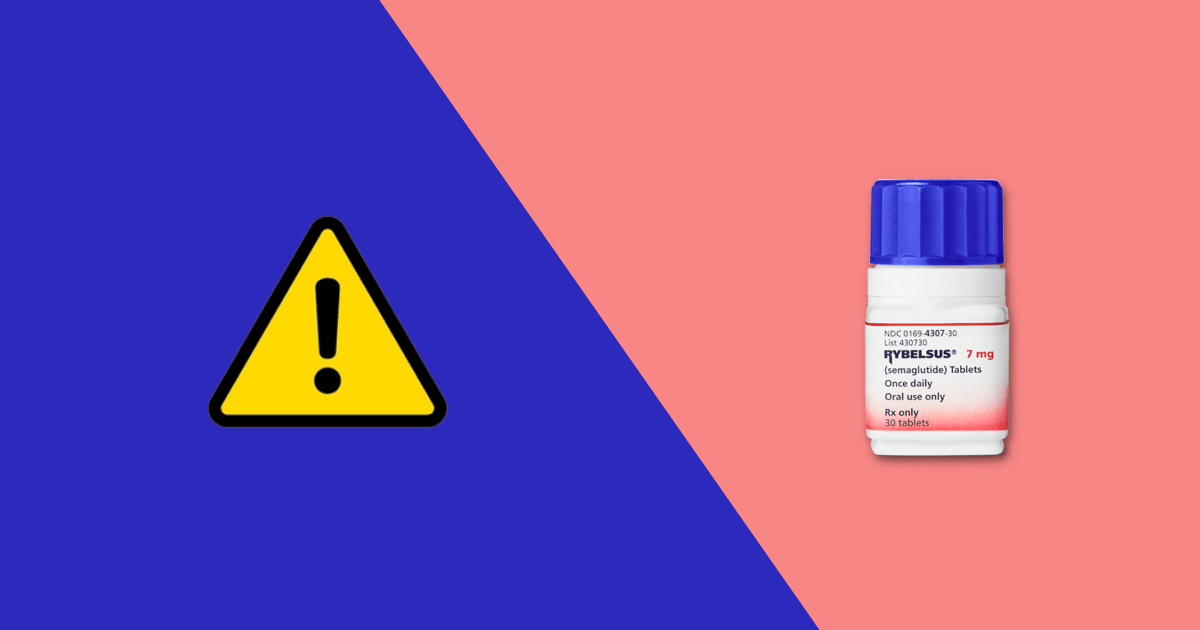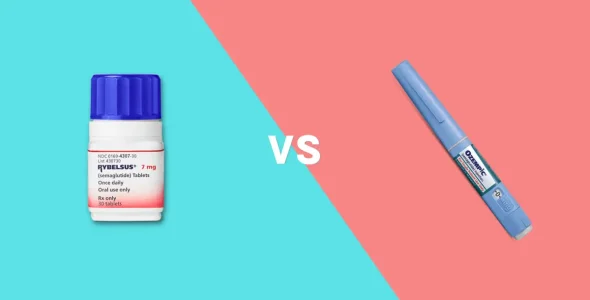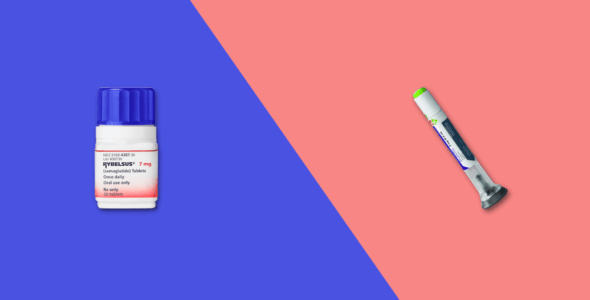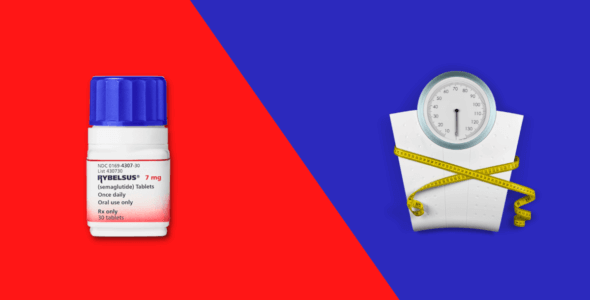Rybelsus side effects and how to avoid them
Rybelsus is a brand-name medication that is manufactured by Novo Nordisk. It is classified as a glucagon-like peptide-1 (GLP-1) receptor agonist and is used to help control blood sugar levels in adults with type 2 diabetes. While Rybelsus is generally well tolerated, there are some potential side effects that people should be aware of. The most common side effects of Rybelsus include nausea, headache, and upper respiratory tract infection. Less common, but more serious side effects, can include pancreatitis and low blood sugar levels.
Learn more about the side effects of Rybelsus and what you can do to avoid them.
What is Rybelsus (semaglutide)?
Rybelsus is classified as a glucagon-like peptide-1 (GLP-1) receptor agonist and is used to help control high blood sugar levels in adults with type 2 diabetes. Type 2 diabetes may also cause other medical conditions that could result in tiredness, such as heart disease.
The active ingredient in Rybelsus is semaglutide. It is a glucagon-like peptide-1 receptor agonist (GLP-1) medication that works by mimicking the effects of the hormone glucagon, which helps to regulate blood sugar levels. Semaglutide is a man-made form of the hormone glucagon-like peptide-1 (GLP-1), which is found naturally in the body. Semaglutide is also the active ingredient in another brand-name medication called Ozempic which is also used to treat type 2 diabetes.
GLP-1 receptor agonists are a class of diabetes medications that work by mimicking the effects of the hormone glucagon, which helps to regulate blood sugar levels.
Rybelsus is available in tablet form and is taken by mouth once daily, with or without food. It should be taken at the same time each day to maintain an even level of the medication in your bloodstream.
Always check with your doctor or pharmacist before taking any medication, including Rybelsus, to make sure it is safe for you.
Rybelsus dosage
Rybelsus is available as a 7 mg, 14 mg, or 21 mg tablet. The starting dose of Rybelsus is typically 7 mg once daily. Your doctor may increase your dose gradually over time if needed.
You should take Rybelsus at the same time each day to maintain an even level of the medication in your bloodstream. You can take Rybelsus with or without food. Swallow the tablet whole.
If you miss a dose of Rybelsus, take it as soon as you remember. If it is almost time for you to take your next dose, skip the missed dose and continue on your regular dosing schedule. Do not take two doses of Rybelsus at the same time.
How effective is Rybelsus?
Rybelsus is FDA-approved to improve glycemic control in adults with type 2 diabetes mellitus. In clinical studies, Rybelsus was shown to lower fasting blood glucose levels, hemoglobin A1c levels (a measure of long-term blood sugar control), and post-meal blood sugar spikes.
In the event that Rybelsus, exercise, and diet are not enough to help you adequately lower your blood sugar, your healthcare provider may also prescribe other medications to use in combination with Rybelsus, such as metformin.
Get your Rybelsus medication for only $49 per month
Get StartedRybelsus side effects
It is possible to experience side effects while taking Rybelsus. For most people, the side effects usually go away within a few days or weeks.
The most common possible side effects of Rybelsus include:
- Nausea
- Stomach (abdominal) pain
- Diarrhea
- Decreased appetite
- Vomiting
- Constipation
Rybelsus can cause more serious side effects such as:
- Low blood sugar levels (hypoglycemia)
- inflammation of your pancreas (pancreatitis)
- Serious allergic reactions
- Vision changes / blurred vision
- Kidney failure
If you experience any of these serious side effects, stop taking Rybelsus and seek medical attention immediately. Speak with your doctor right away about any side effect that bothers you or doesn’t go away.
You are encouraged to report any negative side effects of prescription drugs to the FDA. Visit www.fda.gov/medwatch, or call 1-800-FDA-1088.
Rybelsus drug interactions
Rybelsus can interact with other medications including:
- Insulin
- Certain diabetes medications (sulfonylureas, thiazolidinediones)
- Decongestants
- Drugs to treat asthma
- Blood pressure medications (ACE inhibitors, beta-blockers)
- Some antidepressants (SSRIs, SNRIs)
- Drugs used to treat an HIV infection
- drugs to treat attention deficit-hyperactivity disorder
- Drugs to suppress appetite/cause weight loss
- Other oral medications
Before taking Rybelsus, be sure to tell your doctor about all of the medications you are taking to ensure they are safe to take at the same time.
Rybelsus warnings & precautions
Don’t take Rybelsus if:
- You’re allergic to Rybelsus or any of its ingredients
- You’re pregnant or breastfeeding
- You have a history of pancreas problems
- You have severe kidney problems or kidney disease
- You have a history of low blood sugar levels (hypoglycemia)
- You have a history of diabetic ketoacidosis
- you or a member of your family has ever had medullary thyroid cancer (MTC)
- you have Multiple Endocrine Neoplasia syndrome type 2 (MEN 2);
Talk to your doctor before taking Rybelsus if you:
- Have or have had kidney problems
- Have or have had pancreas problems
- Have or have had low blood sugar levels (hypoglycemia)
- Are pregnant or breastfeeding
- Have digestive problems
- Have type 1 diabetes
- Have diabetic retinopathy
- Or a member of your family has or has had Multiple Endocrine Neoplasia syndrome type 2 (MEN 2) or medullary thyroid carcinoma (MTC) or other thyroid tumors
- Have a high heart rate
You should always check with your doctor or pharmacist before taking any medication, including Rybelsus, to make sure it is safe for you.
Other warnings you should know about
- Children and adolescents: Rybelsus is not for use in children or adolescents under 18 years old.
- Elderly: The safety and efficacy of Rybelsus have not been studied in elderly patients.
- Pregnant women: There are no data on the use of Rybelsus in pregnant women. Animal studies have shown reproductive toxicity
- Driving: Rybelsus may cause dizziness or lightheadedness. If you experience these symptoms, do not drive or operate heavy machinery.
- Alcohol: Avoid alcohol while taking Rybelsus as it can increase your risk of low blood sugar levels (hypoglycemia).
How to avoid Rybelsus side effects
The best way to avoid side effects is to take Rybelsus as directed by your doctor. Follow your doctor’s instructions carefully and do not take more or less than prescribed.
If you are experiencing nausea as a side effect, you can try to:
- Eat bland, low-fat foods, like rice, toast or crackers
- Eat foods that contain water such as gelatin and soups
- Avoid fried, sweet or greasy foods
- Avoid lying down after eating
- Go outdoors for some fresh air
- Eat your food more slowly
- Drink clear or ice-cold drinks
If you experience any side effects, talk to your doctor or pharmacist. They may be able to recommend ways to help reduce or prevent some of the side effects.
1. Stick to the recommended dosage
Take your prescribed dose of Rybelsus that has been recommended by your healthcare professional. Do not take more or less than prescribed.
2. Monitor your blood sugar levels
If you have diabetes, it is important to monitor your blood sugar levels closely while taking Rybelsus. Check your blood sugar levels as directed by your doctor and report any changes to your doctor immediately.
3. Drink plenty of fluids
Drink eight to 10 glasses of water or fluids every day to help prevent dehydration, which can make side effects worse.
4. Avoid alcohol
Avoid drinking alcohol while taking Rybelsus as it can increase your risk of low blood sugar levels (hypoglycemia).
5. Don’t skip meals
Eating regular meals and snacks will help to prevent low blood sugar levels (hypoglycemia).
6. Check your feet
If you have diabetes, check your feet for any cuts, sores, or redness regularly. Tell your doctor if you experience any problems with your feet while taking Rybelsus.
7. Know the signs and symptoms of low blood sugar levels
Signs and symptoms of low blood sugar levels (hypoglycemia) include feeling shaky, sweating, fast heartbeat, dizziness or lightheadedness, hunger, confusion, and headache. If you experience any of these symptoms, eat or drink something that will raise your blood sugar level right away.
8. Monitor your weight
Rybelsus may cause weight loss. If you experience unexplained weight loss while taking Rybelsus, get medical advice from your doctor.
9. Tell your doctor about all medications you’re taking
Be sure to tell your doctor about all other medications you’re taking, including over-the-counter drugs, vitamins, and herbal supplements, as they can interact with Rybelsus.
10. Get regular medical checkups
If you have diabetes, it is important to get regular medical checkups and monitor your medical conditions. Your doctor will monitor your blood sugar levels and may adjust your dose of Rybelsus as needed.
Medically reviewed
A medical professional has reviewed this article.


Jamie Winn, PharmD
Jamie Winn, PharmD
Dr. Jamie Winn received his Doctor of Pharmacy in 2002 from the University of South Carolina College of Pharmacy, Columbia, SC. Jamie is a medical reviewer for NiceRx.




